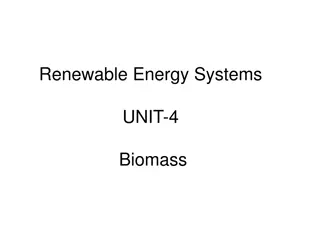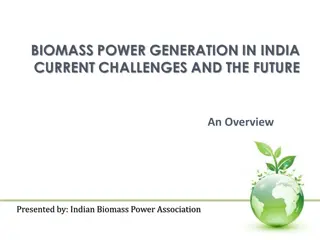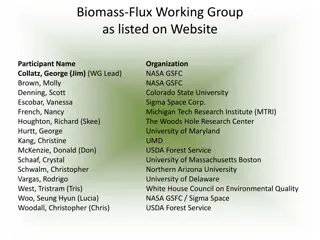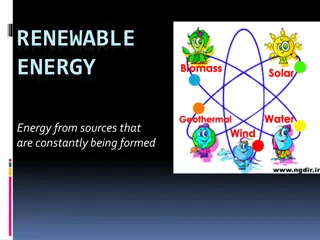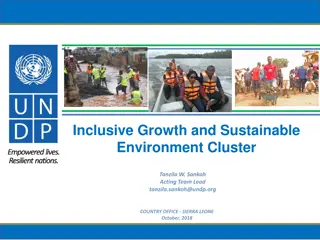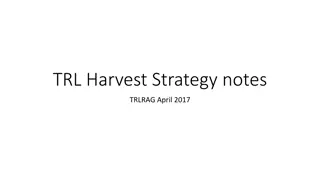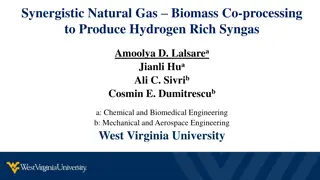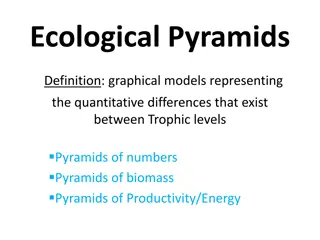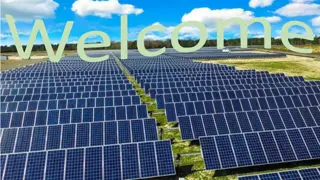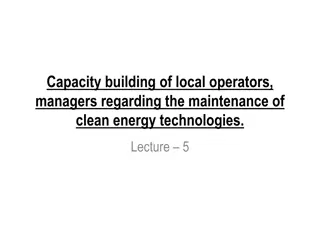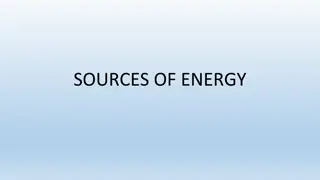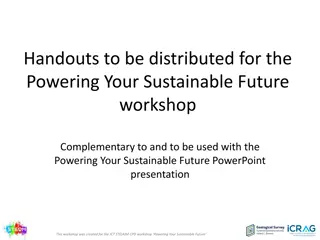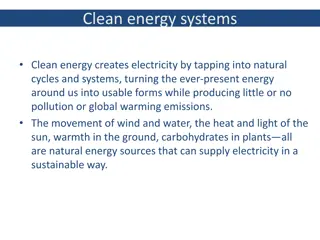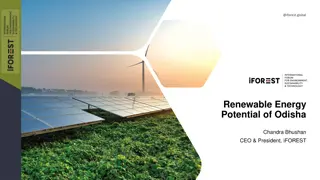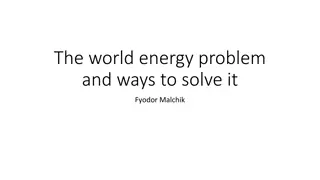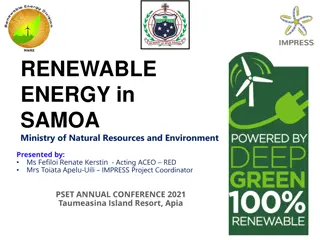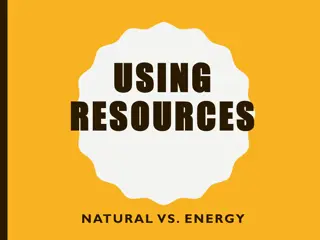Biomass Resources: A Sustainable Energy Source Explored by Dr. R. R. Mistry
Biomass, as presented by Dr. R. R. Mistry, consists of various resources such as trees, cultivated plants, algae, urban waste, and rural waste, which play a crucial role in generating energy through photosynthesis. The conversion of solar energy into biomass energy is primarily achieved through this process. Biomass resources like agro residues, fuel wood, and wet waste offer a significant potential for electricity generation. Advantages of biomass energy include being a renewable and cleaner energy source, aiding in cleanliness, and providing manure for agriculture. However, challenges like land-intensiveness, low energy density, and difficulties in storage and transportation of biogas exist.
Download Presentation

Please find below an Image/Link to download the presentation.
The content on the website is provided AS IS for your information and personal use only. It may not be sold, licensed, or shared on other websites without obtaining consent from the author. Download presentation by click this link. If you encounter any issues during the download, it is possible that the publisher has removed the file from their server.
E N D
Presentation Transcript
Topic Bio-Mass Resources Presented by Dr. R. R. Mistry Asst. Professor Department of Physics Deogiri College, Aurangabad
The Principle biomass resources are:- i) Tree (wood, leaves and forest industry waste) ii) Cultivated plants grown forenergy iii)Algae and othervegetable from oceans and lakes iv) Urban waste(municipal and industrial waste) v) Rural waste (agricultural and animal waste, crop residue etc.)
Animals feed on plants and plants grow through the photosynthesis process using solar energy. Thus the photosynthesis process is primarily responsible for generation of biomass energy. A small portion of the solar radiation is captured and stored in plants during the photosynthesis process. The average efficiency of photosynthesis conversion of solar energy into biomass energy is about 0.5 to 1%. The initial biomass may be transformed by chemical or biological processes convenient intermediate methane, ethanol and charcoal. to bio-fuel produce more such as
A large quantity of biomass is available in our country in the form of dry waste like agro residues, fuel wood, twigs etc. and wet waste like cattle effluents, sugarcane stems etc. the potential for generation of electric power/ cogeneration is 16,881MW from agro residues and 5000MW from bagasse through potential from urban waste is 2,700MW. dung, bagasse, organic banana cogeneration. The
The mainadvantagesof biomassenergy:- 1) It sa renewable sourceof energy. 2) It sacomparatively lesserpollutiongenerating energy. 3) Biomassenergy helps in cleanliness in villagesand cities. 4) It provides manure for theagricultureand gardens. 5) There is tremendous potential togenerate biogas energy. 6) Biomassenergy is relativelycheaperand reliable. 7) It can be generated from everyday human and animal wastes, vegetableand agriculture left-overetc. 8) Recycling of waste reduces pollution and spread of diseases. 9) Growing biomass crops use up carbon dioxide and produces oxygen.
The maindisadvantagesof biomassenergy:- 1) It is dispersed and land-intensive source. 2) It is often of low energy density. 3) Not feasible to set up atall locations. 4) Biogas plant requires space and produces dirty smell. 5) Due to improperconstruction many biogas plants are working inefficiently. 6) It is difficult to store biogas in cylinders.
7) Transportation of biogas through pipeover long distances is difficult. 8) Many easily grown grains like corn, wheatare being used to make ethanol. This can have bad consequences if too much of food crop is diverted foruse as fuel. 9) Crops which are used to produce biomass energy are seasonal and are notavailable over wholeyear.
Wind Energy:- energy is Wind the kinetic energy associated with movement of large masses of air. These motions results from uneven heating of the atmosphere by temperature, density and pressure differences. It is an indirect form of solar energy. Wind energy can be available throughout a 24-hour a day. It is a clean, cheap and eco-friendly renewable source. The wind energy is supposed to be mechanical energy with the helpof a wind turbine. the sun, creating continuously
The mechanical energy obtained can either be used as to operate farm appliances and water pumping or converted to electric power. A generator coupled to a wind turbine is known as aero-generator. Very slow winds are useless because there is no possibility of power generation. On the other hand very strong stormy winds cannot be utilized due to safety of turbine. Moderate to high speed winds typically from 5m/s to about 25 m/s are considered favourable.
Development of wind power in India began in December 1952. Wind power accounts for nearly 10% of India's total installed power generation capacity and generated 62.03TWh in the fiscal year 2018 19, which is nearly 4% of total electricity generation. The capacity utilisation factor is nearly 19.33% in the fiscal year 2018-19. Wind power generation capacity in India has significantly increased in recent years. As of 28 February 2021, the total installed wind power capacity was 38.789 GW, the fourth largest installed wind power capacity in the world. The main disadvantages are it is a dispersed, errotic and location-specific source.
Tidal Energy/ Ocean Energy:- Tidal energy is a form of hydro power that converts energy of ocean tides into electricity or other useful forms of power. It is in the developing stage and although not yet widely used. Tidal power has potential for future electricity generation. predictable than wind energy and solarpower. Tidal energy exploits the natural rise and fall of coastal tidal waters caused by the interaction of thegravitational fields of the sun and the moon. Tides are more
The ocean level difference caused due to tides contains large amount of potential energy. The highest level of tidal water is known as flood tide or high tide. The lowest level is known as low tide or ebb. The level difference between the high and low tide is known as tidal range. The tidal range are varies with location. Only sites with large tidal ranges (about 5 m or more) are considered suitable for power generation.
Tidal mills were in use on the coasts of Spain, France, UK, and China during medieval period, around 1100AD. The first and the biggest a 240 MW tidal power plant was built in 1966 in France at the mouth of the La Rance river near St. Malo on the Brittany coast. A 20 MW tidal plant is located at Nova scotia Canada. There is no functional tidal plant in India at present and the total potential has been estimated as 9,000MW. Three sites have been identified fordevelopmentof tidal energy.
Gulf of Kutch: potential=900 MW, tidal range=5 m. Gulf of Cambay(Khambat): potential=7,000 MW, tidal range=6 m. Sundarbans: potential=1,000MW, tidal range=3.9 m. The Ministry of Non-conventional energy sources has sponsored the preparation of a feasibility report by Renewable Energy Development (WBREDA) to set up a 3.6 MW capacity demonstration tidal Durgaduani Creek in the Sundarbans area of West Bengal. the West Bengal Agency power plant at
The tidal power has many advantages as compared to other form of renewable energy. Tidal are totally predictable. It is completely carbon neutral like wind. A major drawback of tidal power stations is that they can only generate when the tide is flowing in or out. In other words tidal power plants work only for 10 hours each day. Tidal power include higher cost of installation and environmental impact on local area.


